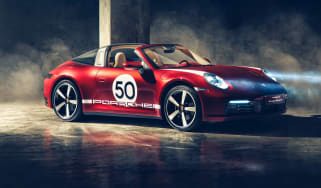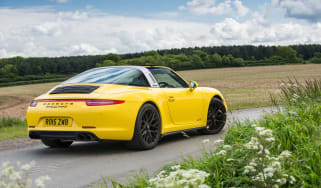Porsche 911 Targa 4 GTS 2025 review – the 911 that shouldn’t make sense
A four-wheel drive, hybrid, open-top 911 sounds like a purists nightmare, but the 992.2 Targa 4 GTS is undeniably impressive
If you were to devise the ultimate driver’s 911, it probably wouldn’t be a hybrid, nor would it have four-wheel drive or a PDK gearbox. And it’d definitely be a coupe rather than a heavier, less rigid open-top version. Where, then, does the Targa 4 GTS fit? The GTS designation usually denotes a hardened Porsche with extra edge, but this latest – and only – version of the 911 Targa is hybrid only and four-wheel drive, and weighs in at 1745kg. Is it the ultimate all-round 911, or a confused concoction of mismatched elements?
The 911 Targa dates back to 1965, but today it’s something of a unique proposition. There isn’t much besides the Mazda MX-5 RF and C8 Corvette that offer a removable roof panel in a coupe-style body, and when you see how intricate and complex the Targa’s roof mechanism is, you start to understand why most stick with a traditional soft top. The enormous, curved rear window raises off the body and arcs backwards, sections of the roll hoop detach to release the roof and everything seamlessly folds away and pieces back together with precision and perfect timing. It’s quite the display.
What you’re left with is a deeply desirable 911 shape, packed with muscle thanks to the 992’s wide bodyshell but much more distinctive than a regular coupe or cabriolet. The roof mechanism does come with a weight penalty, though – at 1745kg the Targa is the heaviest 911 you can buy, and 100kg more than the equivalent coupe. The GTS has huge reserves of power to shift that mass, though, with a mighty 534bhp 3.6-litre hybrid engine that feels part Turbo, part GT3 in how it delivers its punch. It’s a big shift from the previous 992.1-generation car, which had a 473bhp 3-litre twin-turbo unit.
More reviews
Group tests
In-depth reviews
- Porsche 911 review 2025 – Gen2 992 is the 911 for the digital age
- Used Porsche 911 (991, 2011 - 2018) review – should you buy the unloved 911?
Long term tests
Reviews
The latest GTS is the first 911 to be electrified, and it’s brilliantly executed. The engine, already larger than the 3-litre unit in other 992.2 Carreras, is boosted by a single turbocharger with an integrated electric motor to minimise lag. There’s a bigger e-motor mated to the eight-speed PDK gearbox (there’s no manual option), with a 1.9kWh battery pack mounted at the front. That all sounds very complicated, but the simple fact is that the Targa GTS responds and performs like a heavy-hitting, big-capacity naturally aspirated car, with enormous torque at the bottom end that blends into intense power as you wind the revs up. There isn’t much sense that electric motors are doing some of the work, until you realise that no single-turbo engine should react so sharply to the throttle. With the roof stowed you have access to a crisp flat-six howl too (some of which sounds synthesised, it must be said).
Stretching the engine with the roof down also reveals an unfortunate side effect of the Targa roof design. Something about the aperture and enormous bowl of glass catching the air behind you results in a surprisingly high amount of resonance and buffeting at motorway speeds. A pop out wind deflector at the top of the windscreen improves things but doesn’t completely eradicate the issue, and it's a shame the cabin isn’t calmer when driving the Targa as intended. Speaking of which, much of the interior will be familiar to outgoing 992 owners, with a mix of physical controls and digital elements as well as classic 911 cues. Build quality is good, ergonomics are sensible, and the driving position is pretty much spot on. What switchgear there is (for the climate controls, for instance) is tactile and precise, and the HMI is largely intuitive. New for the 992.2 is a fully digital instrument pack, which trades the old, gorgeous analogue central rev counter for more pixels and functionality.
Get moving and you quickly realise the Targa is an enjoyable and fantastically capable 911, despite what the raw facts might suggest. For all its additional weight and complexity some – if not all – of the hard-top GTS’s abilities shine through, and it’s hard not to be impressed by how the Targa dissects a road. There isn’t the same clarity and precision as the coupe but the fundamentals are sound, with a lack of shimmy through the body and a general sense of poise and accuracy. There’s a softer edge to the damping too, which allows more body movement but still gives a sense of underlying control. Switching to Sport gives a more connected ride but also a calmness to the body control as the speed climbs, the Targa jinking over bumps in one clean movement and never running away from you. It gets better the harder you drive.
There’s a definite feeling of heft when you put more load through the car, and while this does take away from the GTS’s agility and ability to hunt into the meat of a corner, the weight isn’t overbearing at road speeds. Instead you can concentrate on pouring through corners, setting the car up for the straights and extracting the most from that powertrain. Push harder and there’s a wide window of adjustability to play with, too, to the point where you never really wish the Targa was rear-drive instead. You can drive it on the throttle and balance it just-so from apex to exit, or be aggressive and play with bigger angles. It feels very rear-biased and can bite back, but also engages the front axle to find immense traction as the car straightens up.
Any snags? As in other GTSs, the brake feel could be more positive near the top of the pedal, with a slightly woolly initial travel and reassuring bite thereafter (which could be a by-product of the hybrid system’s regen). It can also feel wide at the hips on tight roads, and at a motorway cruise the fat rear tyres kick up some noise in that typical 911 fashion. By and large though, this is a talented and entertaining 911 that feels more cohesive than its component makeup might suggest – even if we’d ultimately steer towards the GTS coupe for the most thrilling drive.
Price and rivals
You pay handsomely for the 911 Targa’s spread of abilities – £149,100, to be precise – but there aren’t many directly comparable open-top sports cars. More GT-orientated options with conventional fabric roofs include the £147,855 Mercedes-AMG SL55 and £169,585 Maserati GranCabrio Trofeo.
The C8 Corvette Stringray, meanwhile, offers a pure sports car experience for £100k, with a mid-mounted naturally-aspirated V8 and a manually removable hard top that can be stored in the boot. If you can stretch to £180,000, a nearly-new Maserati MC20 Cielo would offer a bigger adrenaline hit than any of these.










